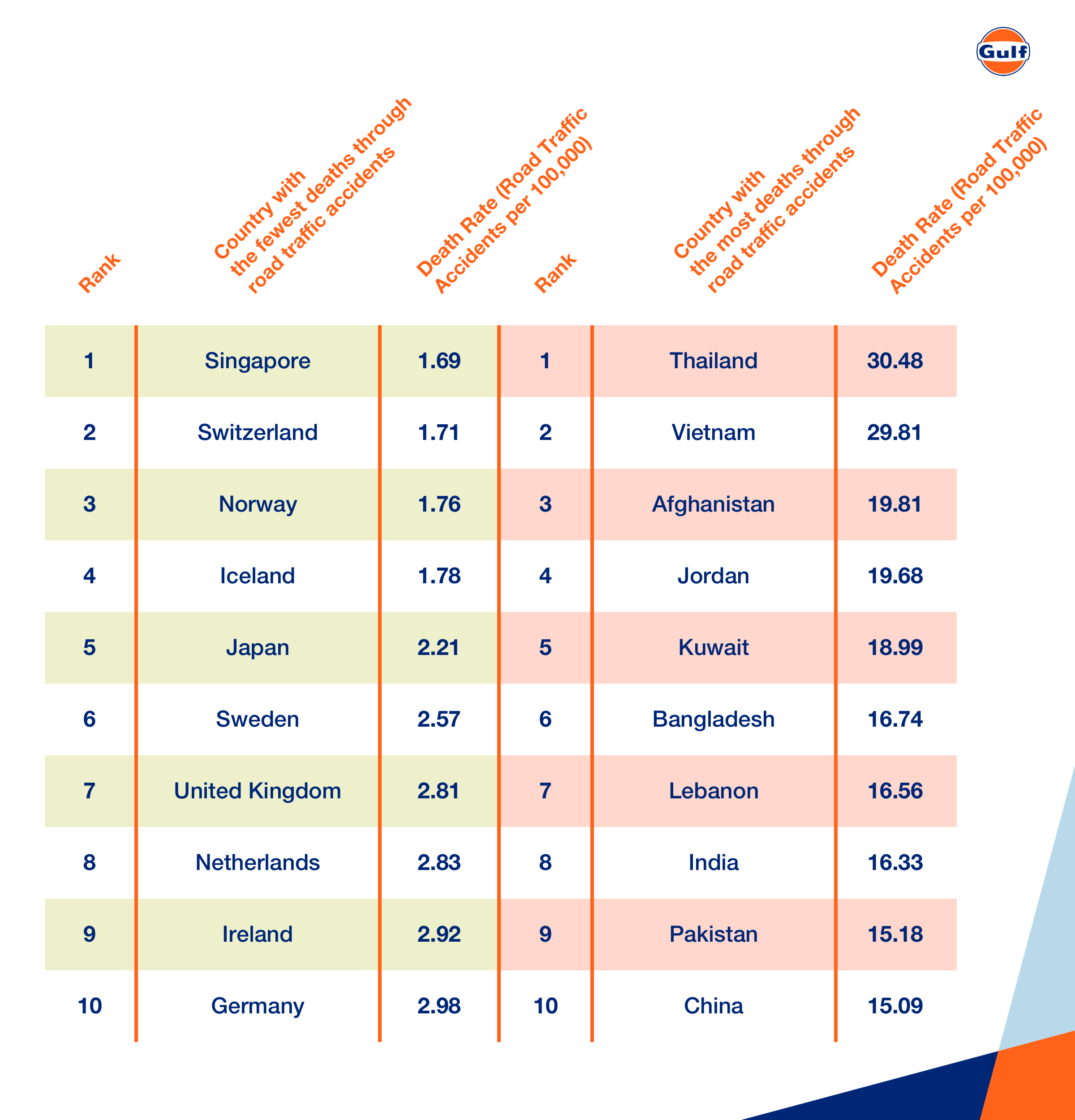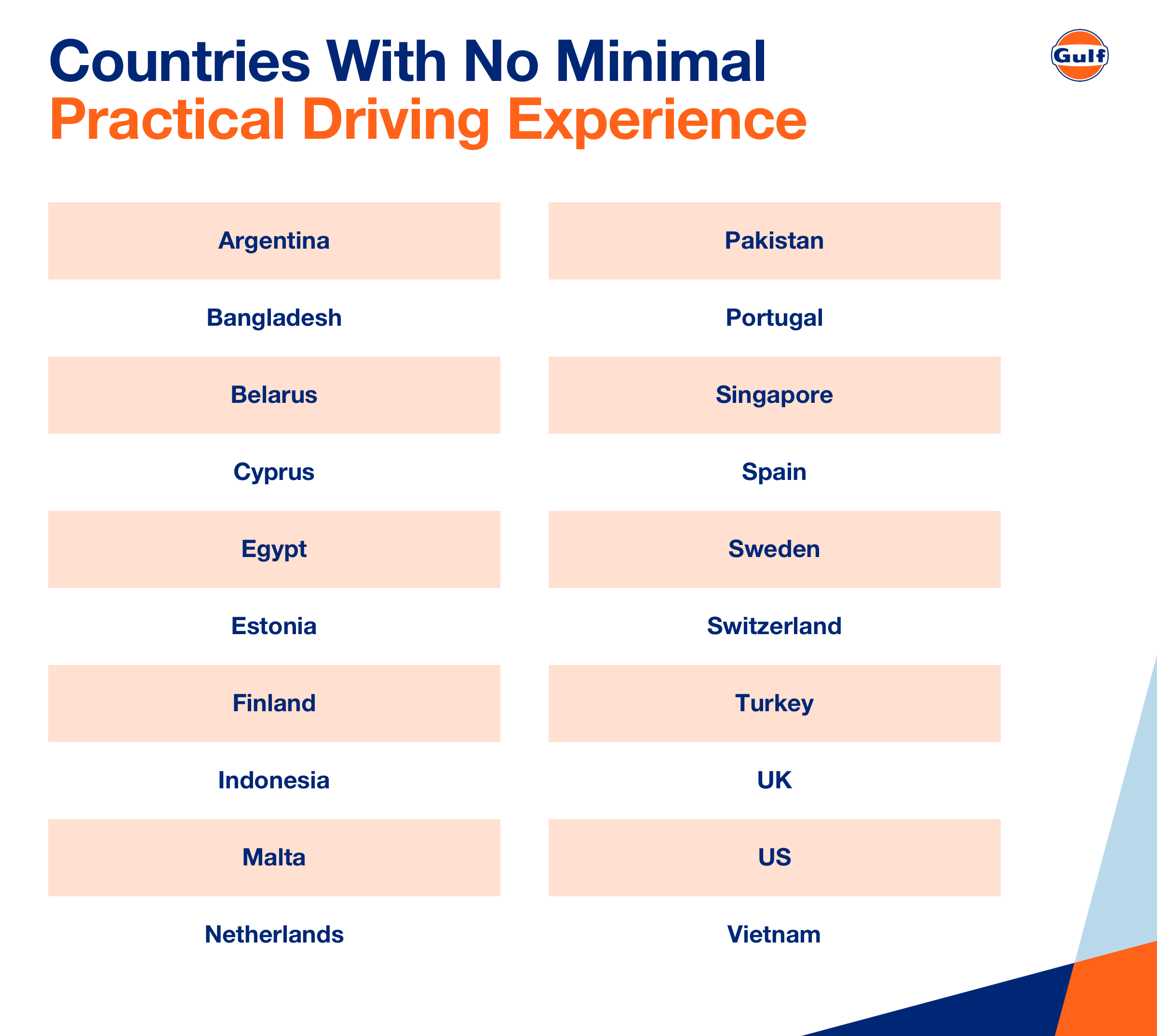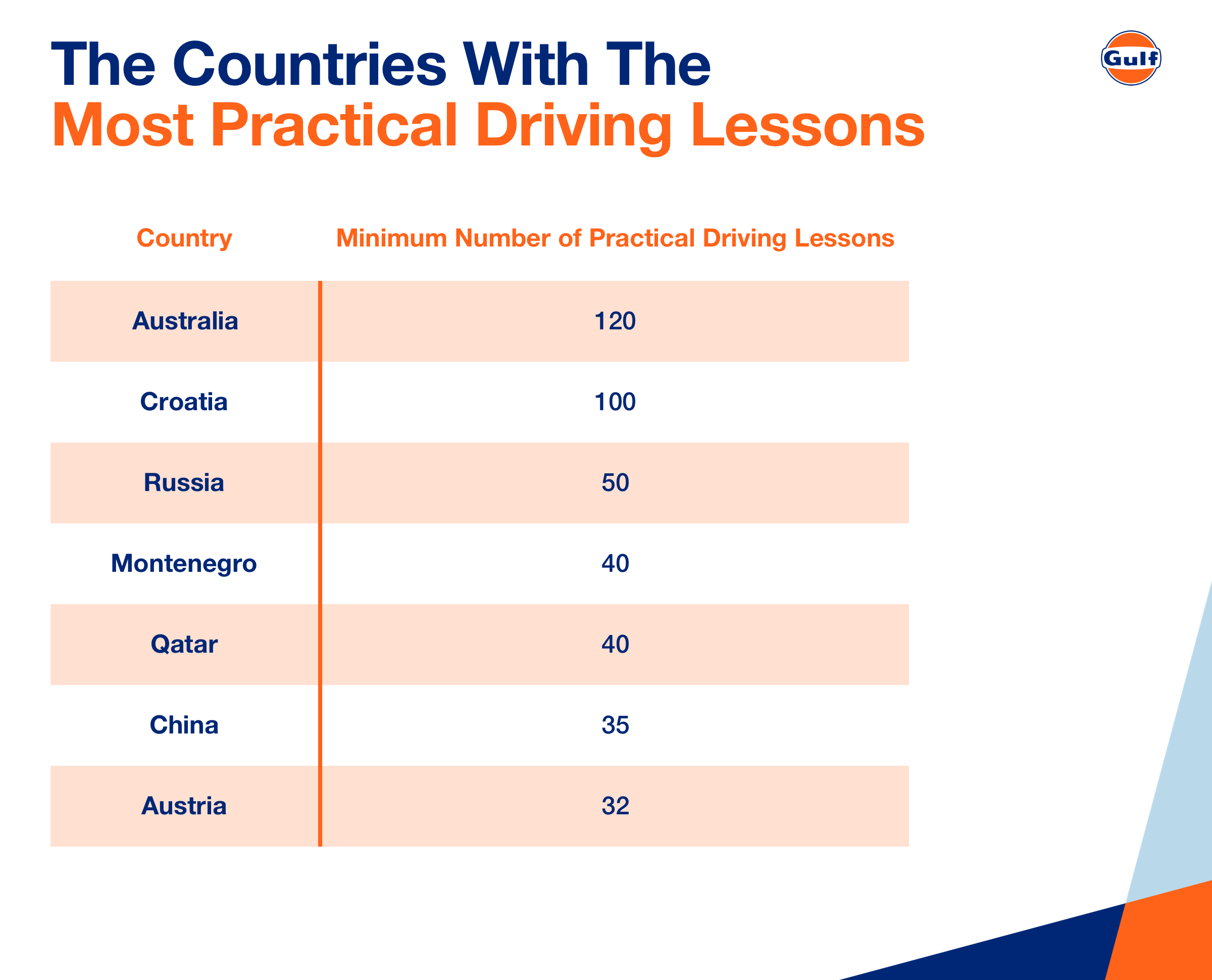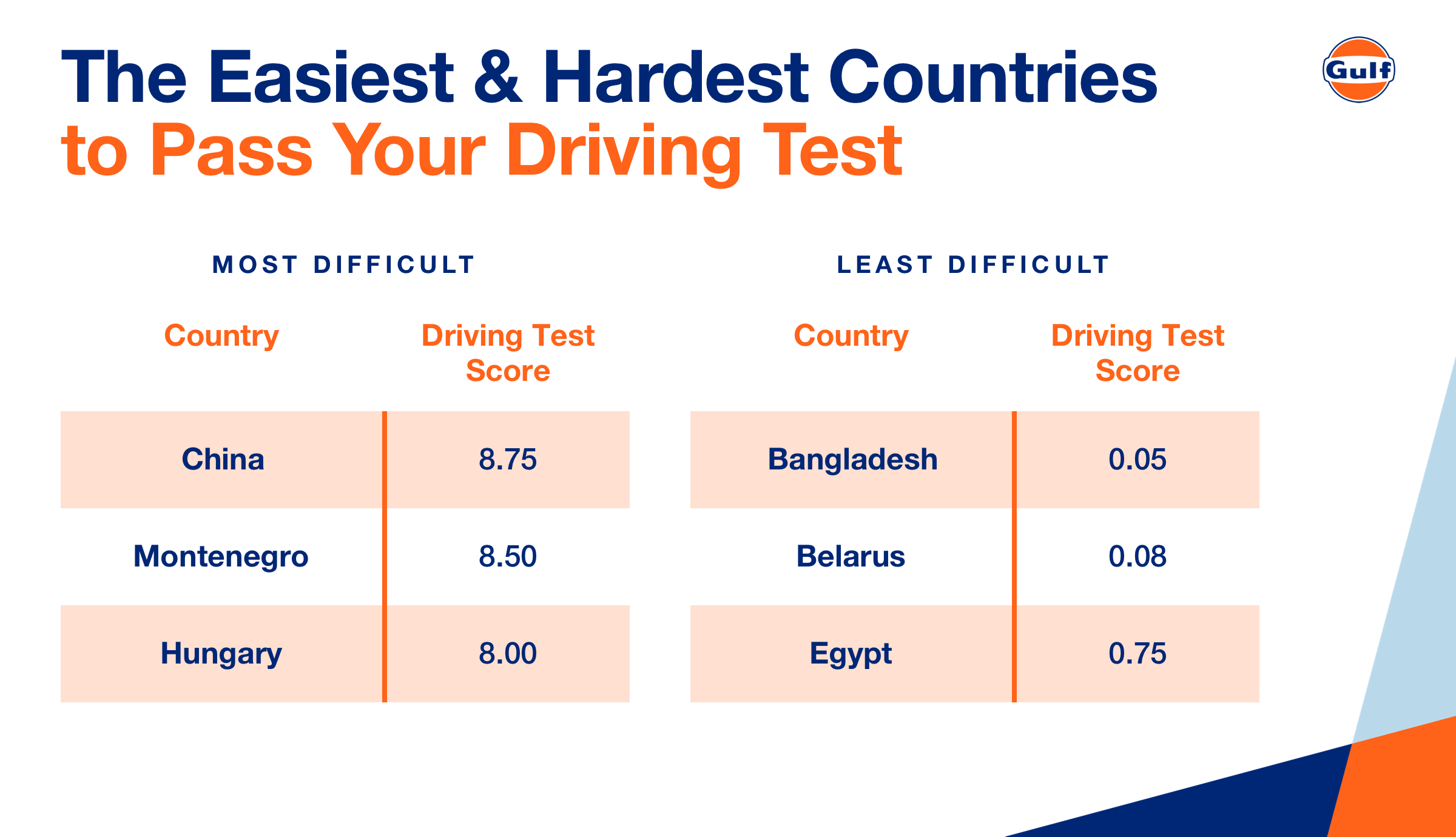Driving Standards Around the World
28 Mar 2023
Have you ever wondered which country has the most competent and clued up drivers? We have. Have you ever questioned which countries have the most deaths caused by road traffic accidents?
Gulf Oil International has recently completed a study to compare driving standards around the world. We looked at:
- The differences in the volume of road traffic accidents
- Which countries have the most comprehensive driving theory tests
- Which countries require the most practical driving experience to obtain a licence
The table below shows the top 10 countries with the fewest road accidents compared to the top 10 countries with the most.
Which Countries Have The Fewest Deaths Caused by Road Traffic Accidents?
(Source: WORLD HEALTH ORGANISATION (WHO) 2020. Data compares road traffic accidents per 100,000 of the population and includes all road users.)

There are many different factors that contribute to a higher number of road traffic accidents. However, research conducted by WHO shows that countries who put more measures in place to achieve the ‘safe system approach’ to road safety, have fewer deaths caused by road traffic accidents.
The cornerstones the safe system approach are.
- Safe roads and roadsides
- Safe speeds
- Safe vehicles
- Safe road users
Countries who have stricter rules around drink driving, speed, helmets, seat belts and child seats, directly limit deaths on their roads. Vehicle standards also play an important part, particularly the eight minimum standards for vehicle manufacture and assembly.
Measures to promote safe road users include driving tests. However, driving test requirements hugely vary worldwide.
Comparing Driving Tests Around the World
Did you know that the world's first mandatory national driving test was introduced in France in 1899? While France was first off the mark in requiring a driving test, other countries did not follow suit straightaway. In fact, the first mandatory test in the UK wasn’t until 1934.
In 1934 there were only 2.5 million vehicles on Britain’s roads, and 7,343 people were killed in road accidents. However, by 2004 there were over 30 million vehicles and the Department of Transport report on road casualties (2004) quoted only 3,221 fatalities. The introduction of mandatory driving tests played a vital role in reducing fatalities.
While driving tests are important for improving road safety, mandatory driving tests aren't standardised. While most countries require drivers to pass a theory exam as well as a practical test, the intensity of these requirements vary drastically from country to country.
We conducted a worldwide study into the different requirements needed to pass driving theory and practical driving exams to drive a car.
Which Countries Have the Hardest Driving Theory Tests?
China is renowned for having one of the most comprehensive driving theory tests in the world. The Chinese driving theory test consists of 100 questions from a bank of over 1000 questions (which is a lot to memorise!) To make it even harder, the pass rate is 90%.
In Japan, you have to complete a theory test consisting of 50 questions before you can even obtain a learner’s permit. To pass the test for a full driving licence, learners must answer a further 100 questions as part of the official theory test.
The pass rate for driving theory tests in Hungary is 70%, which doesn’t sound too difficult. However, what makes this test much harder is that learners are expected to answer 75 questions and only have 60 seconds to answer each one. This makes Hungary the third most difficult country to pass a driving theory exam.
Which Countries Have the Easiest Driving Theory Tests?
Bangladesh has the easiest driving theory test, which consists of just 9 questions.
Egypt and Belarus aren’t far behind as the easiest places to pass a driving theory test. Learners only need to answer 10 questions. In Egypt, driving theory tests weren’t actually introduced until recently, and participants only have to answer 80% of the questions correctly to pass.
In India and Bahrain, the driving theory test consists of 15 questions. In India, the pass rate is 60%.
Interested to know which countries have the most driving theory questions? Take a look at the table below which has been collated through our own independent research.

Comparing the Minimum Number of Driving Lessons Needed
In Australia, learner drivers must complete 120 hours of practical driving before they can even sit a practical driving test. This is the highest requirement of all the countries that we studied.
The country with the second highest number of practical driving hours required was Croatia, with 100 hours. Interestingly, learner drivers in Croatia are also assessed on their personality type and fitness to drive.
In Russia, 50 hours of driving experience is required, making it the third highest. This could be to prepare learners for not one, but two practical driving tests they need to pass. The first practical test consists of an obstacle driving course which is followed by an on-road exam.
In contrast, there are over 20 countries that don’t have a minimal threshold for practical driving experience. This includes:

Interested to know which countries have the highest minimum requirement for practical driving lessons? Take a look at the table below.

Where are the Easiest & Hardest Countries to Pass Your Driving Test?
We gave each country an index score to reflect how stringent the process is to learn how to drive. The index score equally rates driving theory and practical driving requirements. Countries with the most driving theory questions were given higher scores, and the same approach was taken with the number of practical driving hours required.

China, Hungary and Montenegro are the hardest countries to pass your driving test. On balance, these countries have tough theory tests and require more practical experience before being able to sit a practical test.
In contrast, Bangladesh, Belarus and Egypt are the easiest countries, with minimal theory and practical experience needed to sit a driving test.
Fun Facts
- In Japan, drivers must stay at 19mph or under during the entire test or they fail instantly.
- In India, driving examiners were not required to sit in the vehicle until 2013 - pass rates dropped by 50% when this changed.
- The Spanish highway code is the most detailed in Europe and is three times the length of the UK.
- In Greece, there tends to be two examiners in the back of the car during the test, with the instructor in the front.
- Driving tests in Pakistan require you to simply drive through a short track marked out by cones and then reverse back.
- In Finland, night driving and a skid pan session to help learners adjust to driving in the rain is part of the practical test.
Methodology
The dataset was compiled through research into each country. We have not included countries where full datasets could not be found.
You can find the full dataset here:
https://docs.google.com/spreadsheets/d/1Grmksns5B8o5MrYF_zjltR3hsnyxkOEtUvfE_tOKFNo/edit#gid=0





